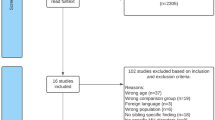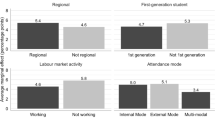Abstract
Purpose
The prospects and predictors of returning to the labour market after long-term work disability in psychoses are unclear. Our aim was to study the proportion and characteristics of persons with schizophrenia and other psychoses who return to the labour market after receiving a disability pension.
Methods
In this 50-year follow-up study in the Northern Finland Birth Cohort 1966 (NFBC1966), national registers on demographics, care, and disability pensions were used to detect and characterize individuals who had been on a disability pension for psychiatric reasons. We compared individuals with schizophrenia (SZ, n = 223) or other psychoses (OP, n = 200) to those with non-psychotic psychiatric disorders (NP, n = 1815) regarding demographics and end of pension by cross-tabulations and logistic regression.
Results
Of the 170 (74%) persons with SZ who had been on disability pension for a psychiatric reason, 15 (9%) returned to the labour market. Corresponding percentages were 19% for OP and 28% for NP. In SZ, being married, a later onset age of psychosis, and better school performance, and in OP and NP, having children predicted returning to the labour market. In all groups, a shorter length of the latest disability pension associated with returning to the labour market.
Conclusion
Although rare, it is possible to return to the labour market after a disability pension due to psychosis. Factors predicting a return to the labour market could be taken into account when planning rehabilitation.
Similar content being viewed by others
Data availability
The data is under gated access. Data is available from the NFBC project center (NFBCprojectcenter@oulu.fi) for researchers who meet the criteria for accessing confidential data (www.oulu.fi/nfbc).
References
Evensen S, Wisløff T, Lystad JU, Bull H, Ueland T, Falkum E (2016) Prevalence, employment rate, and cost of schizophrenia in a high-income welfare society: a population-based study using comprehensive health and welfare registers. Schizophr Bull 42(2):476–483
Hakulinen C, McGrath JJ, Timmerman A, Skipper N, Mortensen PB, Pedersen CB, Agerbo E (2019) The association between early-onset schizophrenia with employment, income, education, and cohabitation status: nationwide study with 35 years of follow-up. Soc Psychiatry Psychiatr Epidemiol 54(11):1343–1351
Marwaha S, Johnson S (2004) Schizophrenia and employment: a review. Soc Psychiatry Psychiatr Epidemiol 39(5):337–349
Hakulinen C, Elovainio M, Arffman M, Lumme S, Pirkola S, Keskimäki I, Manderbacka K, Böckerman P (2019) Mental disorders and long-term labour market outcomes: nationwide cohort study of 2 055 720 individuals. Acta Psychiatr Scand 140(4):371–381
Miettunen J, Lauronen E, Veijola J, Koponen H, Saarento O, Taanila A, Isohanni M (2007) Socio-demographic and clinical predictors of occupational status in schizophrenic psychoses-follow-up within the Northern Finland 1966 Birth Cohort. Psychiatry Res 150(3):217–225
Karpov B, Joffe G, Aaltonen K, Suvisaari J, Baryshnikov I, Näätänen P, Koivisto M, Melartin T, Oksanen J, Suominen K, Heikkinen M, Isometsä E (2017) Level of functioning, perceived work ability, and work status among psychiatric patients with major mental disorders. Eur Psychiatry 44:83–89
Jääskeläinen E, Juola P, Hirvonen N, McGrath JJ, Saha S, Isohanni M, Veijola J, Miettunen J (2013) A systematic review and meta-analysis of recovery in schizophrenia. Schizophr Bull 39(6):1296–1306
Desiron HAM, de Rijk A, Van Hoof E, Donceel P (2011) Occupational therapy and return to work: a systematic literature review. BMC Public Health 11(1):615
Joensuu M, Mattila-Holappa P, Ahola K, Kivimäki M, Tuisku K, Koskinen A, Vahtera J, Virtanen M (2019) Predictors of employment in young adults with psychiatric work disability. Early Interv Psychiatry 13(5):1083–1089
Virtanen M, Kawachi I, Oksanen T, Salo P, Tuisku K, Pulkki-Råback L, Pentti J, Elovainio M, Vahtera J, Kivimäki M (2011) Socio-economic differences in long-term psychiatric work disability: prospective cohort study of onset, recovery, and recurrence. Occup Environ Med 68(11):791–798
Rantakallio P (1988) The longitudinal study of the northern Finland birth cohort of 1966. Paediatr Perinat Epidemiol 2(1):59–88
Filatova S, Marttila R, Koivumaa-Honkanen H, Nordström T, Veijola J, Mäki P, Khandaker GM, Isohanni M, Jääskeläinen E, Moilanen K, Miettunen J (2017) A comparison of the cumulative incidence and early risk factors for psychotic disorder in young adults in the Northern Finland Birth Cohorts 1966 and 1986. Epidemiol Psychiatr Sci 26(3):314–324
Nietola M, Heiskala A, Nordström T, Miettunen J, Korkeila J, Jääskeläinen E (2018) Clinical characteristics and outcomes of psychotic depression in the Northern Finland Birth Cohort 1966. Eur Psychiatry 53:23–30
The Social Insurance Institution of Finland (2014) Statistical yearbook of the social insurance institution, 2013. Vammalan Kirjapaino, Sastamala
Finnish Centre for Pensions (2020) Disability pension, Finland. https://www.etk.fi/en/the-pension-system/pension-security/earnings-related-pension-benefits/disability-pension/. Accessed 21 April 2020
Pirkola S, Nevalainen J, Laaksonen M, Fröjd S, Nurmela K, Näppilä T, Tuulio-Henriksson A, Autio R, Blomgren J (2019) The importance of clinical and labour market histories in psychiatric disability retirement: analysis of the comprehensive Finnish national-level RETIRE data. Soc Psychiatry Psychiatr Epidemiol. 5 December 2019
Marwaha S, Balachandra S, Johnson S (2009) Clinicians’ attitudes to the employment of people with psychosis. Soc Psychiatry Psychiatr Epidemiol 44(5):349–360
Falkum E, Klungsøyr O, Lystad JU, Bull HC, Evensen S, Martinsen EW, Friis S, Ueland T (2017) Vocational rehabilitation for adults with psychotic disorders in a Scandinavian welfare society. BMC Psychiatry 17(1):24
Rinaldi M, Montibeller T, Perkins R (2011) Increasing the employment rate for people with longer-term mental health problems. Psychiatrist 35(9):339–343
van der Noordt M, IJzelenberg H, Droomers M, Proper KI (2014) Health effects of employment: a systematic review of prospective studies. Occup Environ Med 71(10):730–736
Chan SKW, Chan HYV, Devlin J, Bastiampillai T, Mohan T, Hui CLM, Chang WC, Lee EHM, Chen EYH (2019) A systematic review of long-term outcomes of patients with psychosis who received early intervention services. Int Rev Psychiatry 31(5–6):425–440
Correll CU, Galling B, Pawar A, Krivko A, Bonetto C, Ruggeri M, Craig TJ, Nordentoft M, Srihari VH, Guloksuz S, Hui CLM, Chen EYH, Valencia M, Juarez F, Robinson DG, Schooler NR, Brunette MF, Mueser KT, Rosenheck RA, Marcy P, Addington J, Estroff SE, Robinson J, Penn D, Severe JB, Kane JM (2018) Comparison of early intervention services vs treatment as usual for early-phase psychosis: a systematic review, meta-analysis, and meta-regression. JAMA Psychiatry 75(6):555–565
Tandberg M, Ueland T, Andreassen OA, Sundet K, Melle I (2012) Factors associated with occupational and academic status in patients with first-episode psychosis with a particular focus on neurocognition. Soc Psychiatry Psychiatr Epidemiol 47(11):1763–1773
Tsang HWH, Leung AY, Chung RCK, Bell M, Cheung W (2010) Review on vocational predictors: a systematic review of predictors of vocational outcomes among individuals with schizophrenia: an update since 1998. Aust N Z J Psychiatry 44(6):495–504
Lauronen E, Miettunen J, Veijola J, Karhu M, Jones PB, Isohanni M (2007) Outcome and its predictors in schizophrenia within the Northern Finland 1966 Birth Cohort. Eur Psychiatry 22(2):129–136
Immonen J, Jääskeläinen E, Korpela H, Miettunen J (2017) Age at onset and the outcomes of schizophrenia: a systematic review and meta-analysis. Early Interv Psychiatry 11(6):453–460
Ritsner M, Sherina O, Ginath Y (1992) Genetic epidemiological study of schizophrenia: reproduction behaviour. Acta Psychiatr Scand 85(6):423–429
Hultin H, Lindholm C, Möller J (2012) Is there an association between long-term sick leave and disability pension and unemployment beyond the effect of health status? A cohort study. PLoS ONE 7(4):e35614
Andrade L, Caraveo-Anduaga J, Berglund P, Bijl R, Kessler R, Demler O et al (2000) Cross-national comparisons of the prevalences and correlates of mental disorders. Bull World Health Organ 78(4):413–426
Caspi A, Houts RM, Ambler A, Danese A, Elliott ML, Hariri A, Harrington H, Hogan S, Poulton R, Ramrakha S, Rasmussen LJH, Reuben A, Richmond-Rakerd L, Sugden K, Wertz J, Williams BS, Moffitt TE (2020) Longitudinal assessment of mental health disorders and comorbidities Across 4 decades among participants in the dunedin birth cohort study. JAMA Netw Open 3(4):e203221
Acknowledgements
We thank all cohort members and researchers. We also wish to acknowledge the work of the NFBC project center.
Funding
Oulu University Hospital funding (basic government funding for hospitals).
Author information
Authors and Affiliations
Corresponding author
Ethics declarations
Conflict of interest
The authors declare that they have no conflict of interest.
Ethical statement
The NFBC1966 study has been approved by the Ethics Committee of the Northern Ostrobothnia Hospital District and relevant keepers of the registers. The study has been performed in accordance with the ethical standards laid down in the 1964 Declaration of Helsinki and its later amendments. According to Finnish legislation, individual consents are not needed for solely register-based studies.
Code availability
Not applicable.
Supplementary information
Below is the link to the electronic supplementary material.
Rights and permissions
About this article
Cite this article
Majuri, T., Haapea, M., Huovinen, H. et al. Return to the labour market in schizophrenia and other psychoses: a register-based Northern Finland Birth Cohort 1966 study. Soc Psychiatry Psychiatr Epidemiol 56, 1645–1655 (2021). https://doi.org/10.1007/s00127-020-02009-1
Received:
Accepted:
Published:
Issue Date:
DOI: https://doi.org/10.1007/s00127-020-02009-1




